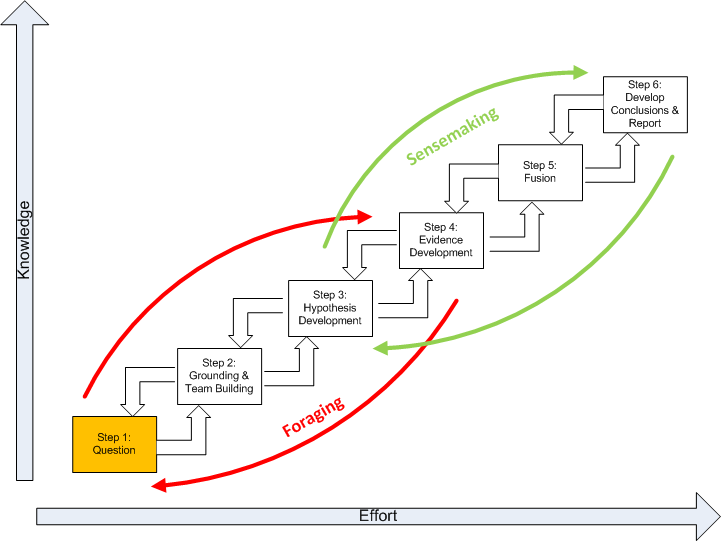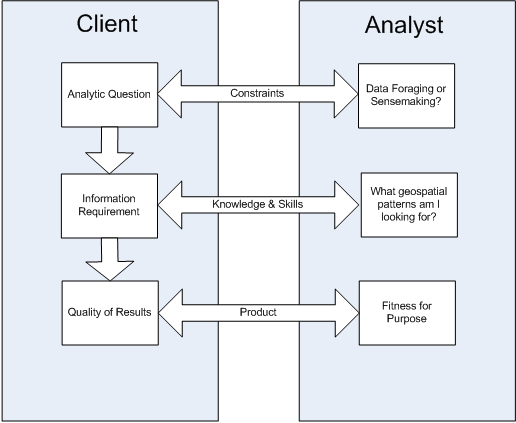Chapter 4 - Develop the Geospatial Question
Chapter 4 Overview
This chapter discusses the first step of the SGAM, highlighted below in gold, the Analytic Question.

The question, or analytical problem, can be viewed as an active two-way interface between the client requiring the information and the geospatial analyst supplying it. The problem defines the geospatial patterns the analyst is seeking. Foraging and sensemaking define the nature of the analysis and quality in this context defined as satisfying the client. A geospatial question that leads to the sensemaking process must meet three criteria of:
- At least one plausible explanation exists with some geospatial aspect.
- Counter-explanations are possible.
- The hypotheses can be defined sufficiently with respect to the geospatial aspects to allow us to gather evidence.
Therefore, the problem possesses a highly strategic significance. The figure below depicts a three-way connection between the client and analyst’s domain:

Before beginning, ask the following questions:
- Who is the key person for whom the analysis is being completed?
- Do I understand the question? (If necessary, clarify this before proceeding.)
- What is the most important message to give this client?
- How is the client expected to use this information?
- How much time does the client have?
- What format would convey the information most effectively?
- What is the client’s level of tolerance for technical geospatial specific language? How much detail and what geospatial accuracy does the client expect?
- Would the client expect the analyst to reach out to other experts within or outside the Intelligence Community?
- To whom, or to what source, might the client turn for alternative views on this topic? What data or analysis might others provide that could influence how the client reacts to what is being prepared in this paper?
The question focuses the analyst on the nature of the spatial and temporal patterns the analyst is seeking to identify and understand. Many new geospatial analysts struggle to translate the question into the context of spatial concepts. To overcome this, we stress the importance of understanding the general analytical question and developing a spatial corollary of this broader question.
What is an analytic question? There are significant differences between a “factoid question,” which are the most common in Geospatial Intelligence, and an “analytical question.” A factoid question seeks a piece of information that would be answered with a corresponding true statement. For example:
Question: “How many miles are between two shooter events?”
Answer: “There are 5 miles between events."
In general, a factoid question usually has just one correct answer that can be easily judged for its truthfulness. Answers to factoid questions are important as evidence but are not to be the focus of an analytic effort. Data foraging provides factoids (or evidence), a small but potentially important bit of information. In contrast to a factoid question, an analytical question has a less certain relationship with expected answer. For example:
Question: “Who is the DC Shooter?”
Answer: “The shooter could be a foreign terrorist or a serial killer.”
In general, an analytical question has many possibly correct answers that cannot be easily judged for truthfulness. An analytical question is generally quite flexible in the sense that there is always a strong possibility that we may not arrive at the “expected” answer. Thus, a change of analytic strategy, and even the initial expectations of the analysis, may be warranted. This suggests a solution to an analytic question must involve iterative information foraging and sensemaking.
Geospatial Corollary
The Geospatial Corollary is a highly spatial problem statement which follows readily from the broader analytic problem, and suggests a narrowly focused spectrum of geospatial questions. The evidence developed as part of the spatial corollary contributes to the larger body of evidence of the initial analytic problem; the spatial corollary is unlikely to be as significant to the stakeholder as those of initial analytic problem statement. The development of this spatial corollary involves an active two-way discussion between the client requiring the information and the geospatial analyst supplying it. For example, “What geospatial aspects of the events help to explain if the DC Shooter is a foreign terrorist?” The spatial corollary must be “analytic” which means four conditions are met:
- It must be at least one spatial quality or relationship to be explained;
- At least one plausible explanation of the spatial quality or relationship must be posed;
- Counter-explanations are possible and analysis must include an investigation of alternative hypotheses; and
- The hypotheses must be capable of being defined sufficiently to allow us to gather spatial evidence.
Memory Aid
Actions That Help Define the Analytic Question
Action 1: Develop an understanding of the general analytic question. Understanding the general question will require a two-way dialog between the client requiring information and the geospatial analyst supplying it. The distinguishing characteristics of an “analytical question” in geospatial intelligence are:
- That the analyst cannot anticipate the answer without reasoning.
- While certain answer may be expected, the result is for the most part unknown and heavily biased by the available data.
- The initial efforts probe the available data with other probes determining follow up questions. In our case, these will be geospatial questions.
- Clarifications will possibly be needed to adjust the scope and intent of the question.
Action 2: Familiarize yourself to the problem. Before finalizing the question, the analyst must have a preliminary and broad base of knowledge about the problem. When dealing with a new and unfamiliar subject, the uncritical and relatively non-selective accumulation and review of information is necessary. This is a process of absorbing information, not analyzing it.
Action 3: Think about the Spaces. An object or event can be specified relative to the observer, to the environment, to its own intrinsic structure, or to other objects in the environment. Each instance requires the adoption of specific spatial frames of reference or context. The spatial context is critical because it is the space the data is in that ultimately determines its interpretation. There are three spatial contexts within which we can make the data-to-information transition. In all cases, space provides an interpretive context that gives meaning to the data. These include:
- Life spaces - Life space is the four-dimensional space-time that provides the means of coming to grips with the spatial relations between self and objects in the physical environment. This is cognition in space and involves thinking about the world in which we live. It is exemplified by navigation and the actions that we perform in space. For example, the route the sniper took between shootings.
- Physical spaces - Physical space is the four-dimensional space-time that focuses on a scientific understanding of the nature, structure, and function of phenomena. This is cognition about space and involves thinking about the ways in which the "world" works. An example might be how an earthquake creates a tsunami. Another example is the sniper's weapon had a certain range the projectile will travel.
- Intellectual spaces - Intellectual space is in relationship to concepts and objects that are not in and of themselves necessarily spatial, but the nature of the space is defined by the particular problem. This is cognition with space and involves thinking with or through the medium of space in the abstract. An example is perceived extent of tribe influence by a tribal leader. Another example might be areas where the sniper felt safe from detection.
Action 4: Think about the fundamental spatial questions. When making sense about the spaces (Gershmehl and Gershmehl, 2006) the analyst first asks and answers the following questions each of the life, physical, and intellectual spaces:
- Where is this object or event?
- What is at this object or event?
- How is this object or event linked to other objects and events?
Action 5: Think about the qualities of the objects or events for each space. The analyst then proceeds to examine the object or events for each space by asking the following questions:
- How are objects or events similar or different?
- How can we compare them fairly?
- What effect(s) does the object or event have on nearby areas?
- What nearby objects or events are similar to each other and can be grouped together?
- Where does this object or event fit in a hierarchy?
- Is the change between objects or events abrupt, gradual, or irregular?
- What distant objects or events have similar situations and therefore may have similar conditions?
- Are there clusters, strings, rings, waves, or other non-random arrangements of objects or events?
- Do objects or events tend to occur together (have similar spatial patterns)?
Action 6: Think about the relationship between the objects and event for each space. Last, the comparisons are placed into the context of space and time. This is spatiotemporal thinking which asks the questions:
- How do spatial objects or events change through time?
- How do conditions change at a place over time?
- What is the change in position of something over time?
- What is the change in extent of something over time?
- Where are the objects or events that do not seem to follow an observed “rule”?
Action 7: Write the Geospatial Corollary. The geospatial corollary is a highly spatial problem statement which follows readily from the broader analytic problem, and suggests a narrowly focused spectrum of geospatial questions. The evidence developed as part of the spatial corollary contributes to the larger body of evidence of the initial analytic problem; the spatial corollary is unlikely to be as significant to the stakeholder as those of initial analytic problem statement. The development of this spatial corollary involves an active two-way discussion between the client requiring the information and the geospatial analyst supplying it. The spatial corollary must be “analytic” which means four conditions are met:
- there must be at least one spatial quality or relationship to be explained;
- at least one plausible explanation of the spatial quality or relationship must be posed;
- counter-explanations are possible and analysis must include an investigation of alternative hypotheses; and
- the hypotheses must be capable of being defined sufficiently to allow us to gather spatial evidence.